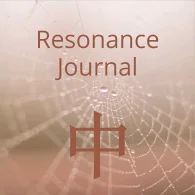Here is a wholly new approach to multiple changing lines, from an equally new I Ching blog. It’s another method for isolating a single line among the many to focus on. This isn’t something I’m generally very interested in, myself. I take the view that you’re given more than one line for a reason, and ‘contradictory’ lines can also represent contradictions, choices, or different ‘layers’ of reality. So I’d be one of those readers, who, as the author puts it, “still feel that it’s necessary to consult all the lines that are changing for fear that they would be discarding some significant piece of information if they did otherwise.” (And no, I don’t find that this results in such confusion as to be unviable!)
However, if I were in search of a method to eliminate parts of a reading, I’d be interested in trying this one out. It has the advantage of some simple principles behind it – like the idea that the ‘action’ is more intense towards the centre of the hexagram – that make it intuitively easy to relate to. They also make it easy to memorise – I think it’s lodged in my head successfully after a single read-through – which would make it simpler to try out than the more technical approaches. I’ve subscribed to Eric’s blog, hoping for more.









If you apply Eric’s rules then your interpretation of the oracle will sometimes agree with Zhu Xi’s rules (and my slight adaptation), and sometimes not. Eric’s rules though take little account of change moving upwards in a hexagram. In my view if your application of Eric’s rules leads you to favour a lower line of a two-line change then you will be misinterpreting. It is all very well to come up with rules that seem to have a rationale (though actually Eric’s rules aren’t really any less arbitrary than other methods), but the main thing is whether the rules or methodology you apply work in practice over a long period. The apparent arbitrariness of some aspects of Zhu Xi’s rules is neither here nor there, when you have tested them extensively in practice and find them to provide accurate interpretations. Eric’s approach, though interesting, seems mainly about providing a set of rules that have an apparent logic, but what matters is whether he has found them to work, not whether they sound well thought out.
Agreed. The idea of posting a link here is to give people interested in these methods a chance to test them out. Do you have a link to your adapted Zhu Xi rules?
http://www.biroco.com/yijing/basics.htm#rules
Steve says: “but the main thing is whether the rules or methodology you apply work in practice over a long period.”
If that is indeed the main criterion, then all theories as to why these rules work are irrelevant and immaterial. Unless of course, you say, this theory works in practice for this person, and that theory works in practice for that person.
I tried going by the Nanjing Rules with a reading that I had that had all 6 lines changing. I got Hexagram 37, and, with all 6 lines changing, it added up to 48. I subtracted 48 from 55, and I got 7! But there aren’t 7 lines in a Hexagram, there are only six! So which line would be the ruling line for me according to the Nanjing Rules?
Here are the rules:
http://www.russellcottrell.com/VirtualYarrowStalks/NanjingiRules.htm
Looks like when you get remainder 7, you read line 6… though maybe not if all lines are changing… hm, perhaps I shouldn’t be trying to understand this on a quick skim-through…